Hurricanes Over Yucatan
Editor's Note: This article was originally published in 2008. Since then, many hurricanes have passed near, through or around the Yucatan Peninsula. None of them have done as much damage as Hurricane Wilma (2005) or Hurricane Isidore (2002) to the Yucatan Peninsula so far. Hurricane Wilma was one of history's most destructive hurricanes, if you measure destruction by damage of property. Wilma caused 63 deaths, 8 of which happened in Mexico, and over $29 BILLION USD in damages. You can read all the gory details in this Wikipedia article. And now, guess what? It is hurricane season again! When the clouds gather and start to swirl, our thoughts turn to what we can do to prevent damage or prepare to wait out what might be coming towards us, because you just never know. A few years ago, Hurricane Ernesto had everyone along the Mayan Riviera stocking up their pantries and taping their windows, but Ernesto did relatively little damage. In Merida, Ernesto felt more like a storm than a hurricane. But one of these days, the approaching hurricane is bound to fufill our worries about the damage it can do, so it is best to be prepared. Perhaps this article on hurricanes in Yucatan will help.
The End of Summer... Not So Fast!
You might find yourself in Merida at the end of the summer. As you watch the children return to school throughout the Yucatan, you might think that the threat of hurricanes is over. If you think that, think again. Hurricane Wilma revved up to hurricane status on October 18, right at the end of the season (which technically begins on June 1 and ends on November 1). September is recognized as the busiest month for hurricanes in the Atlantic. NOAA, the last word on hurricanes, predicted a near-normal season for the 2012 hurricane season, though they also have admitted this year that their 6-month forecasting ability is more like a guess, and not a skill. The season started even before the official start date of May 1 this year, but ended up very quiet. Just another lesson that hurricanes and hurricane seasons are nothing if not unpredictable.
Give Us A Hurricane Anyday
Every place on the planet has a tendency towards some natural disaster. Where we Working Gringos come from in California, we've been through raging fires whipped up by seasonal warm winds and sudden violent and devastating earthquakes. We've had acquaintances die and watched houses hang and then fall from cliffs in deadly mudslides. When it comes to our personal fear factor, we'd rather be living in the land of hurricanes. Give us a hurricane any day!
Isidore Approaches
We first moved to Merida in the winter of 2002. The weather was beautiful, with warm days, cool evenings and an occasional flashy thunderstorm. Perfect, we thought! Then summer hit... okay, maybe not quite so perfect, but certainly we could handle it. The summer often included afternoon thunderstorms which we found refreshing, in a tropical sort of way. Just when we thought summer was over and the days would be cooling off, September 22nd rolled around, and we were witness to Hurricane Isidore, a Category 4 hurricane. Hurricane Isidore was headed towards Texas when it took an unpredicted and unexpected hard left turn from its trajectory across the Gulf of Mexico, and barreled right over the Yucatan Peninsula and right over Merida, hanging over the city in all its Category 4 glory for about 12 hours.
For about three days we had watched Isidore on various weather websites (we list the best ones that we know of at the end of this article). We hadn't expected more than the edge of it to pass by Merida, until we watched it change direction. When that happened, we, along with everyone else here, battened down the hatches and waited for the almost-inevitable.
Out and About in a Hurricane
When the winds and rain started picking up and it was pretty certain that the hurricane was coming, we turned off our computers and ventured outside with our cameras. This was our first hurricane and we didn't want to miss a minute of it! Our house, like most here, didn't have much of a view onto the street, so the best way for us to see what was going on was to get out into it. We walked down towards Santa Ana Park in shorts and t-shirts and took photos of ourselves standing in calf-deep water in the middle of the Motor Electrico intersection (Calle 49 and Calle 62). Other than an occasional police vehicle, there wasn't a car or a person in sight. This should have given us pause for concern, perhaps, but we were too busy enjoying the rush of the intense weather.
We kept walking, taking short videos with our little digital camera of the wind whipping the awnings around and swinging the stoplights on their cables. As we reached the park, the wind started picking up and we got great shots of the palm trees next to the church being blown hard in the winds. We saw a cell phone tower that must have been 30 meters high shudder a bit and then fall down completely. It was when a piece of lamina (corrugated tin roofing) flew by almost horizontally that it occurred to us that strolling around in a hurricane wasn't such a good idea. We made our way back without a scratch or an incident and went inside our house to wait it out.
Watching and Waiting
Our house at the time was a 100-year-old colonial that had probably withstood more than five or ten such hurricanes (Casa Panadero, which you can see here). We felt very safe within Casa Panadero's thick stone walls. Most of the windows were French-style doors that opened into the courtyard or into the garden, and most of them had wooden doors that closed over them to protect them from the elements. The ones without external protectors rattled a bit and leaked a lot, but even during the most powerful winds, did not break. We did learn, however, that with fragile windows it might be best to open them in a hurricane (if you can), rather than risk them being blown apart by the wind. Water and leaves are a lot easier to pick up than broken glass.
The power went out shortly after we returned from our ill-advised adventure, and we lit up the candles. It was hard to relax, though, because hurricanes are incredibly noisy. Not only was there the sound of the wind, the rattling doors and the rain, but there was the high-pitched whining of the wires strung from various cell and radio towers near the house. There was also an old veleta (windmill) across the street that was whirring faster than the designer intended and throwing sparks in its frenzy. (That veleta never did fall down, although it did lose most of its blades before the end.) The noise was deafening, the rain was intense, and we spent a lot of time plugging up leaks around the windows with our towels, trying to prevent the storm from coming in the house. Silly mistake, but we didn't know any better at the time.
The hurricane raged on throughout the night and at about two in the morning, we had gotten used to the noise. Not only that, we were exhausted from the excitement and the leak-plugging and we finally fell asleep. It seemed incongruous at the time to fall asleep with such weather raging outside. But we didn't seem to be in any danger, so we saw no reason to stay awake, and were grateful that we were able to get some needed rest.
The Aftermath
When we woke the next morning, the storm was almost gone and we were left to assess the mess. And, oh, what a mess it was!
Our neighbor's lovely mango tree that used to drop ripe mangos into our yard had lost a few limbs and been whipped about unmercifully in the course of the storm. Eventually, the tree would die and be removed, as mango trees do not tolerate stress well. Our own trees were all pretty young at the time, and though some of them were practically horizontal, we propped them back up and they went on to live healthy lives. No plant in our garden was left untouched, and many plants were naked of their leaves. The leaves had gone through the Cuisinart of a Category 4 hurricane and leaf-bits were strewn everywhere. We would find leaf-bits for the next six months in corners behind doors, in crevasses between stones... everywhere!
My Kingdom for Electricity
It wasn't long before we noticed that it was getting quite hot again. During the storm, despite the fact that all the doors and windows were closed, we had been fairly comfortable. But the next morning, the temperature started to rise, and we had no electricity. Every towel we owned was wet because we had used them to stem the flow of water that had seeped in through, under and above the old doors. The floors that did get wet dried fairly quickly. But did we mention there was no electricity? As the temperature climbed into the 30's (Celsius), we realized we had no air conditioning, no fans, no washer and drier, no Internet, no nothing. We had candlelight at night, and we had phone service (but only a wireless phone system which used, you guessed it, electricity). For the next five days (which is how long it took for the electricity to be turned on in our part of the centro), we endured the most difficult part of the hurricane. We were prompted to go right out and buy a generator, which as it turns out, we have not had occasion to use since. We discovered that sitting through a hurricane (in a safe spot) was nothing compared to dealing with the wet humidity for five days afterwards without the basic comforts of modern life. It wasn't horrible, but it wasn't fun either.
Out and About Afterwards
When the hurricane had passed, we were one of the first to go out in our car and look around. The hurricane had indeed wrought havoc with our beautiful Merida. Huge trees were down in the Plaza Grande, along Paseo de Montejo and just about everywhere we looked. Our friend at Casa Santana had a tree fall onto the house (This was repaired quickly, and a new ceiba tree was planted a few months later, which was huge just four years later). Any stores that had large plate glass windows now had piles of broken glass and debris in front of their facades. We found the employees of Triunfo, the store on Paseo de Montejo, emptying out the store and bringing everything down to the garage so they could clean up. They were back in business within a week, as we recall. The car dealerships had been badly hit and their lots were strewn with broken glass and twisted aluminum. Billboards were ripped to shreds. There was some flooding in the southern areas of the centro, but the drainage in most parts of Merida was incredibly effective.
Paseo de Montejo and the Prolongación were barely passable and full of debris. Leaves? yes. Tree limbs? yes. Soldiers? Yes! Soldiers! The Mexican Army was out in force, moving trees out of the street, cutting trees that were too big to move and directing traffic. They were a beautiful sight to see, called out to help with a disaster and coming to aid their fellow Mexicans. People were out in the streets, and were already starting to clean up their yards and assess their damages. Over the next few weeks, large piles of tree limbs, leaves and other green waste would appear outside people's houses in the centro to be carried away by the garbage companies. The electricity was restored to the buildings around the Plaza Grande after one day, and most of the city had electricity within a week. It took another month to get electricity out to the pueblos, which included replacing over 5,000 concrete electrical poles which had snapped and fallen in the high winds.
The Yucatan Countryside
Of course, there were those who were not so lucky. The day after the hurricane was over, we drove to Costco and WalMart, both of which were operating on their own generators and were open the same day that the hurricane passed. Knowing that the people out in the pueblos probably didn't fare as well as those in Merida, we stocked up on basics like rice, beans, diapers, water and masa (cornmeal used for tortillas). We set out to visit our friends in the May family in Oxtapacab, to see how they were doing and to give them some of the supplies that we had in the truck if they needed them.
It takes about an hour to drive to Oxtapacab from Merida. Along the way, we passed kilometers and kilometers of beaten-down selva (forest), every tree stripped of leaves, and hundreds of those fallen concrete power poles. In some pueblos, the houses were high and dry but missing their palapa roofs, and the families appeared to be living outside. In others, the houses were below the level of the road and were flooded in up to two or three feet of water. When we got to Oxtapacab, we were pleased to see that the May family had survived well. They have two concrete houses (bunkers, basically) on their property, and they stayed in those during the hurricane. They had lost all their turkeys, a lot of trees, and the lamina that covered their outdoor cocina (kitchen). They were grateful for the food and diapers, and promised to share some of it with their neighbors.
On the way back, we still had about half the supplies that we had bought at Costco in the back of the car. We decided to stop in a pueblo where every house was underwater and the people were sitting around looking a bit stunned. We parked, opened up the back of our truck, and asked the people closest to us if they would like some food. Their eyes lit up and before we knew it, the car was surrounded with people, grateful for some free food from the ricos in the truck. It was one time when we really didn't mind being seen that way. The truth was that they needed help and we were pleased to be able to provide some. A little farther on, we were also pleased to see that we weren't the only ones helping. In Timicuy, a town's worth of women in huipiles lined up at the town hall, waiting to receive basic food supplies from a handful of soldiers. Back in Merida the next day, we were also happy to help our street guy, Jose, whose family had survived the storm, but had lost their roof. We gave him the $200 pesos he asked for so he could buy a new lamina roof for his home.
What We Learned About Preparing for a Hurricane
So now that we have lived through a Category 4 hurricane, we have learned a few things. We see that living in Merida, which is not right next to the ocean, is a safer place to live than on the beach. We had a few friends who lost everything at their beach houses, and others who lost nothing. The waves were, not surprisingly, quite capricious in their destruction. Many houses on the coast suffered heavy damages. At the very least, we realized that less preparation for a hurricane is needed in a typical colonial home than in a beach home. We learned from those whose houses did survive at the beach that a beach wall helps, but isn't a guarantee. We also learned that wherever you are, the aftermath can be more difficult to endure than the hurricane.
So next time there is a threat of a hurricane, we will stock up on dry towels and clothes, putting some aside to be used after the worst is over. We'll put gas in the car and make sure our tinacos are full... an empty tinaco can easily fly off the roof during a hurricane and we saw a few. We might go up on our roof and lay down the mini-split air conditioners, because they will probably blow down anyway, they are less likely to be damaged that way and you cannot use them during a hurricane. While we're there, we'll make sure the drains are clean and that water can flow easily. We'll either make sure our satellite dish is secured or we'll unscrew it and lay it down as well. We'll make sure we have an old-fashioned telephone, the kind that gets its electricity from the phone line, so if there is phone service after the storm, we'll be able to use it. And most of all, we won't worry (or let our family worry) about us during the hurricane. After the initial excitement is over, we will try to take the time to rest and read. And enjoy our chance to watch Nature's fury up close, behind the safety of our stone walls.
Recovering in the Yucatan
During Hurricane Isidore, there was a lot of physical destruction of trees and plants, roofs, windows, billboards, power poles and beaches. We heard about two people dying in Merida during Hurricane Isidore: one a worker who was electrocuted and another an extranjero who got up on his roof during the storm. Wikipedia says that overall 17 people died on the Yucatan Peninsula during Hurricane Isidore, but doesn't give any details. This part of Mexico knows how to deal with hurricanes, and they have a long history of surviving them. Because of the good organization of the government and the verdant nature of a tropical environment, both man and nature seem to bounce back quickly after a hurricane in these parts. The recovery of Cancun after Hurricane Wilma is one example. To this day, as we drive along the Maya Riviera we can see small remnants of the massive destruction from that year, but most of it was gone in a few years, replaced by new construction and beautiful plant life. And in Merida, now twelve years later, there is little to no evidence of the destruction wrought by Hurricane Isidore.
Be Forewarned, But Not Afraid
We are not suggesting that anyone take Nature's power for granted, nor would we suggest stepping directly into the face of danger. If you live in the Yucatan, you must resign yourself to dealing with a hurricane at some point during your stay. The word on the street in Merida is that there is a devastating hurricane here every fourteen years or so, which would seem to imply that there will be a hurricane of note sometime before 2016. We've learned to stay inside during a hurricane, and hope you have also. In Merida, most houses are built with stone walls, and many of them have survived many hurricanes, so you will probably be safe if you stay inside your house. We suggest you use internet websites and local newspapers to track the progress of approaching storms. And prepare your tinaco, your air conditioners, your pantry, etc. If a hurricane comes to town, we will all have plenty of warning and practically no worries at all.
****
Want to see more photos? Check out our Hurricane collection in the Photo Gallery!
Places to watch hurricane progress on the Internet
The definitive word is at the National Hurricane Center: www.nhc.noaa.gov
Accuweather's Hurricane Center: hurricane.accuweather.com/hurricane/index.asp
Intellicast's Storm Alert Center: www.intellicast.com/Storm/Hurricane/Track.aspx
Dr. Jeff Master's Blog is a great place to follow the progress of a hurricane.




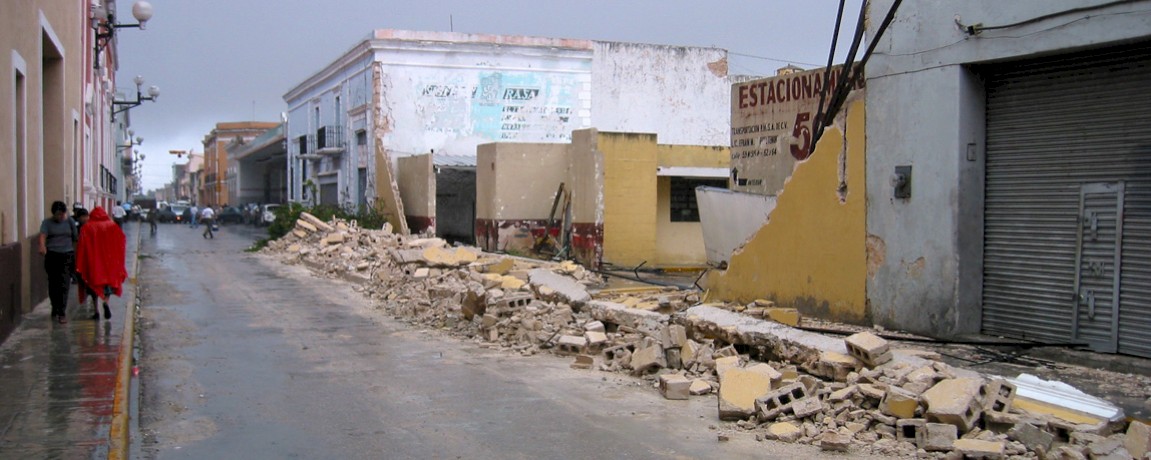


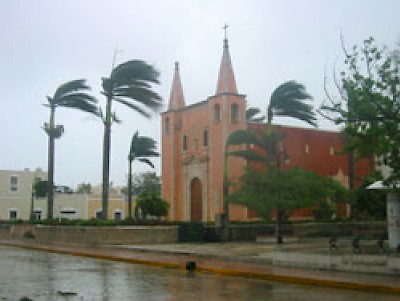


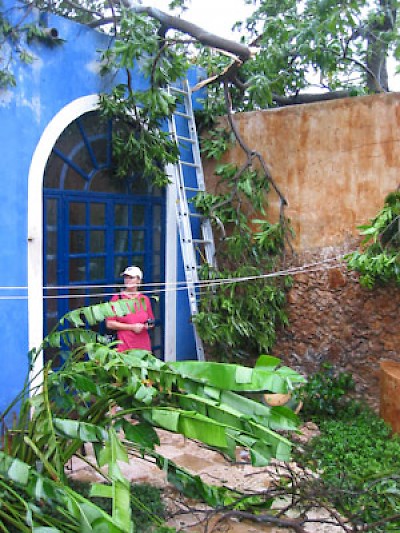

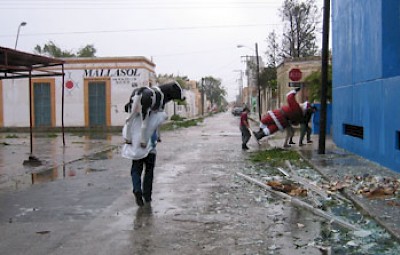

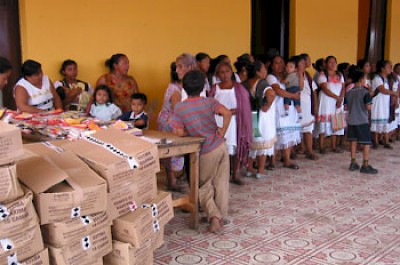
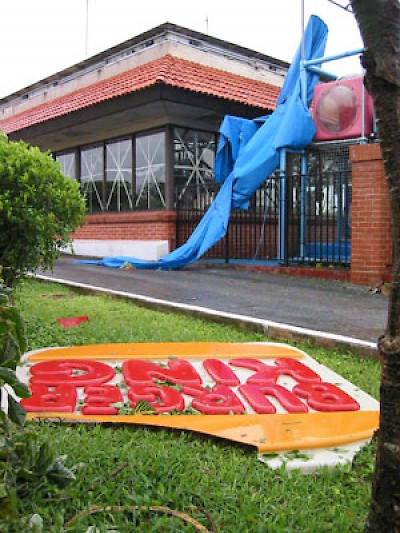


Comments
Paul Borthwick 18 years ago
Due to my own stupidity
I have placed my questions in the wrong category I am truly sorry if I appear unsympathetic I am not.Furthermore I pray that the people of Tabasco will recover soon.
Reply
Paul Borthwick 18 years ago
Hi , and greetings from a cold and wintery Canada it's nov22/2007 we have had a full week of rain and 48hrs of freezing rain and now they are calling for 5-20 inches of snow isn't that just special I would first like to say what a great web site and I have learned a lot from you but I still have lot questions that I hope you can answer for me such as a 15 yr old grade 10 student that needs slight modifications to his program due to a slight learning disability,and with me being diabetic (non insulin) can the schools accommodate my son and can I purchase the same meds in Merida as I can in Canada?.And is the beach living as nice as it looks in the real estate ads? and overall what is the cost of living compaired to the rest of North America? thank you for any and all help...Paul
Reply
Annie 18 years ago
This article was good. I am sorry about what happened.
Reply
Nur 18 years ago
Casi,
Thank you very much for your note.I am looking forward to visiting Cancun and I will keep in mind your recommendations.
I am glad that the Hurricane Dean moved away without any major issues.
Yes,Istanbul is one of the fascinating cities.The bosphorus,the old town,the grand bazaar are very attractive..There is an Istanbul forum on the trip adviser as you migth be already knowing.I hope that one day you visit Turkey.FYI,also the south cost (the Mediterranean sea ) and the west cost ( the Agean sea ) have a lot too see , both historical sides and nice beaches.
Take care,
Nur
Reply
CasiYucateco 18 years ago
Nur,
I hope you enjoy your visit to the peninsula! Please write a note and let we other readers know what you think. I'm curious to hear the perspective of someone who travels from so far away. And Istanbul is a place I've always wanted to visit.
By the way, Chichen Itza is the most famous (probably) but Uxmal is truly a great place to visit also. And, the museum at Dzibilchaltun (conveniently close to Merida) is one of the best, in my opinion. Dzibilchaltun also offers the only known Mayan building with windows (an observatory) and a great cenote for swimming. The beaches at Cancun? Well, those are hard to beat! ENJOY!
Reply
Perry K. 18 years ago
Am praying that all the citizens of Merida weather Hurricane Dean without loss or hardship ... especially the family of Dr. Castillo, whose daughter lived with us here in Nfld. Canada for a few months back in 2004.
Our thoughts and prayers are with them!
Perry, Maxx & Syd
Reply
Kurt King 18 years ago
I woz supposed 2 be visiting the Riviera Maya from Aug. 29-Sep. 5, but it looks like its gonna be postponed....I'm a FLorida native and have MAJOR respek 4 Hurricanes!! Yes, better than quakes since U know their coming, but DEAN looks NASTY!! Best of luck 2 every1 on the Yucatan Peninsula and your in my heart and thoughts here in Las Vegas....now go show DEAN that your not 2 be messed with!!! CHEERS (0:
Reply
Luchia 18 years ago
Thank you for your replies. Our thoughts and prayers are with you in Yucatan - take care and be safe.
Luchia
Reply
Nur 18 years ago
I have been watching the news of "Hurricane Dean " on the TV and reading in the internet.Here in Istanbul-Turkey,I am praying that everyone will be safe when it comes and it will go away with minimum damage.Good-luck.
I've never been to Cancun nor to Yucatan but planning to visit Cancun and Chichen-Itza end of September 07 .
#The world is so empty if one thinks of only mountains,rivers and cities;but to know someone here and there who thinks and feels with us although distant,is close to us in spirit,this makes the earth for us an inhabited garden ( Goethe )#
Reply
anne 18 years ago
God Bless All the People of the Yucatan. I hope that the hurricane will lose strength and not affect anyone too terribly. We live inFLorida and had two within a three week period of time. It is an experiance you are not soon to forget. Our thoughts are with you.
Reply
Carlos Daniel Gallegos 18 years ago
Me and my friends in Texas are praying for everyone's safety in the Yucatan. I called many of my friends and my esposa Ariadna. All are prepared as much as possible. I was in Merida when Emily and Wilma passed over. I was in Fort Worth when a Tornado sliced through downtown Fort Worth in 2000. Have you guys ever been in a Tornado? Especially a Texas Tornado. Otra Vez, my prayers are with everyone. Be Safe.
Reply
« Back (10 to 21 comments)Next »